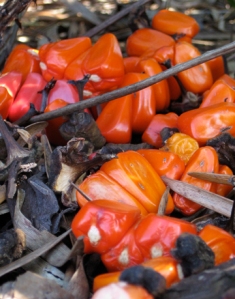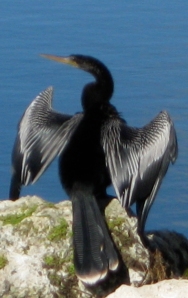
Regular Nature Walk posts will return next month with the unveiling of the results of my yearlong photography project. In the meantime, please enjoy the photos and this recounting of my recent adventures in the Christopher B. Smith Preserve located in Naples, Florida, USA.
I recently had the opportunity to go on a tour of the Christopher B. Smith Preserve located in Naples, Florida, USA. The preserve is owned and managed by The Conservancy of Southwest Florida, an organization that works to preserve the natural habitats of southwest Florida. The preserve is “an eight-acre endangered upland and scrub habitat” and “is home to native plants and wildlife including the gopher tortoise, a threatened species in Florida” (Conservancy).
 Ian Bartoszek, a biologist for The Conservancy and a friend of mine, lead the afternoon tour. As we carefully stepped through the fence and into the preserve the first thing I noticed was that the ground is made up of fine, white sugar sand. It is a soft sand compared to the type often found along the beaches of the Atlantic and it is pure white. The sandy ground made the scrub habitat feel so different from the areas of asphalt and manicured lawns that surround it. The white ground, a leftover seabed from millions of years ago, made this area feel like I was stepping into another world and into another time. Covering most of the sand was a light-green species of lichen, Foliose Ground Lichen (Parmotrema spp). As we walked through the preserve Ian asked all of us to stick to the paths, so as not to disturb this ancient species.
Ian Bartoszek, a biologist for The Conservancy and a friend of mine, lead the afternoon tour. As we carefully stepped through the fence and into the preserve the first thing I noticed was that the ground is made up of fine, white sugar sand. It is a soft sand compared to the type often found along the beaches of the Atlantic and it is pure white. The sandy ground made the scrub habitat feel so different from the areas of asphalt and manicured lawns that surround it. The white ground, a leftover seabed from millions of years ago, made this area feel like I was stepping into another world and into another time. Covering most of the sand was a light-green species of lichen, Foliose Ground Lichen (Parmotrema spp). As we walked through the preserve Ian asked all of us to stick to the paths, so as not to disturb this ancient species.
Looking around I noticed that The Conservancy had installed small wildlife cameras attached to the base of a few trees. The motion activated cameras are able to capture animal activity that people wouldn’t normal get to see and the biologists are able to study these photos and share them with visitors of The Conservancy.
 Also dominating the landscape are the beautiful purple flowers of the Chapman’s Blazing Star plant, also known as Chapman’s Gayfeather (Liatris chapmanii). These pretty flowers are typically a pretty purple color but every now and then, a white one will bloom. Among the sea of purple we found two of these white blooms very near each other. It felt like something special to see these rare flowers. Ian told us that seedpods from
Also dominating the landscape are the beautiful purple flowers of the Chapman’s Blazing Star plant, also known as Chapman’s Gayfeather (Liatris chapmanii). These pretty flowers are typically a pretty purple color but every now and then, a white one will bloom. Among the sea of purple we found two of these white blooms very near each other. It felt like something special to see these rare flowers. Ian told us that seedpods from  established plants like these could be harvested by conservation groups and used in other habitat reclamation projects. The use of these seeds is typical when reestablishing an area that may have had the natural scrub habitat devastated by logging, land clearing and other development.
established plants like these could be harvested by conservation groups and used in other habitat reclamation projects. The use of these seeds is typical when reestablishing an area that may have had the natural scrub habitat devastated by logging, land clearing and other development.
As we walked through the scrub we could hear a gopher tortoise or two shuffling through the palms and undergrowth. The tortoises were camouflaged in the thick growth and I wasn’t able to snap a photo of them on this trip. However, I was able to get a few photos of the entrances to their underground homes, which I put into the slideshow below. In addition to the threatened gopher tortoise, Ian told us that there is a very diverse group of animal and plant species (about 250 of them), from tiny spiders and amphibians to bobcats and coyotes, which live in this protected habitat.
We also found this amazing beehive that covered a good portion of a palm tree. I was lucky enough to have a good zoom on my camera and didn’t need to get to close too these amazing, buzzing pollinators in order to get a good picture (also in the slideshow below).
The preserve is part of The Conservancy of Southwest Florida’s new Nature Center. The center is currently being upgraded and when it is complete it will be open to the public later this year. Ian was able to give our group a quick tour of the progress so far, along with a visit to some of their animal residents, which I included in the slide show below.
I had a wonderful time on my nature walk and can’t wait to come back soon. If you’re going to be in Florida, be sure to stop by The Conservancy’s Nature Center and get a tour of this unique area of Florida. Thank you to our guide, Ian Bartoszek, for showing us around and teaching us about the importance of preserving natural habitats.

.
.
.
[slideshow]




 Also dominating the landscape are the beautiful purple flowers of the Chapman’s Blazing Star plant, also known as Chapman’s Gayfeather (Liatris chapmanii). These pretty flowers are typically a pretty purple color but every now and then, a white one will bloom. Among the sea of purple we found two of these white blooms very near each other. It felt like something special to see these rare flowers. Ian told us that seedpods from
Also dominating the landscape are the beautiful purple flowers of the Chapman’s Blazing Star plant, also known as Chapman’s Gayfeather (Liatris chapmanii). These pretty flowers are typically a pretty purple color but every now and then, a white one will bloom. Among the sea of purple we found two of these white blooms very near each other. It felt like something special to see these rare flowers. Ian told us that seedpods from 











